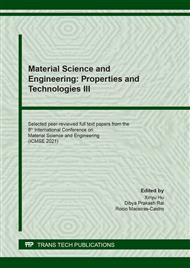p.95
p.101
p.109
p.115
p.123
p.129
p.135
p.145
p.153
Simulation Study on Burning Test of Solid Propellant Based on Apparent Specific Heat Capacity
Abstract:
This document In the process of propellant heat transfer, the specific heat capacity is an important thermodynamic parameter, and temperature is an important factor affecting the specific heat capacity. In this paper, the initial specific heat capacity of HTPB propellant and its components was measured by DSC, and the specific heat capacity value was modified based on the synchronous weight loss curve, and the variation law of specific heat capacity of propellant and its components with temperature increase was obtained. The modified variable specific heat capacity is used to simulate the burning experiment of solid propellant, and the macroscopic curve is compared with the experimental curve. The results show that the absolute error between the simulated ignition delay time and ignition temperature and the experimental results is less than 10%, which indicates that this method provides the key technical parameters for evaluating the weight loss material of propellant, and provides an important parameter basis for designing the heat dissipation mechanism of new propellant.
Info:
Periodical:
Pages:
123-128
Citation:
Online since:
March 2022
Authors:
Price:
Сopyright:
© 2022 Trans Tech Publications Ltd. All Rights Reserved
Share:
Citation:


